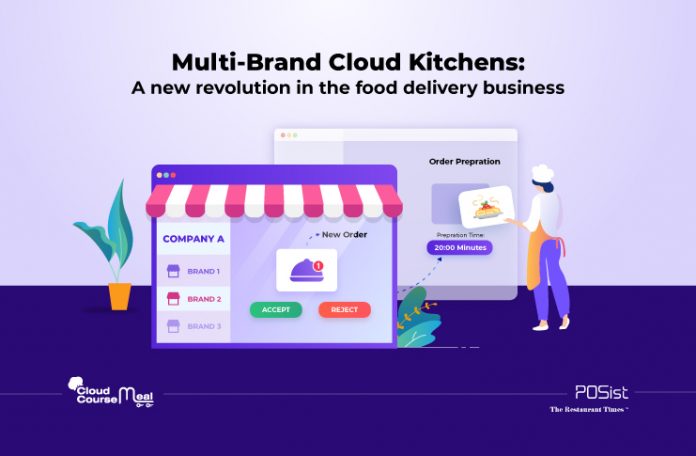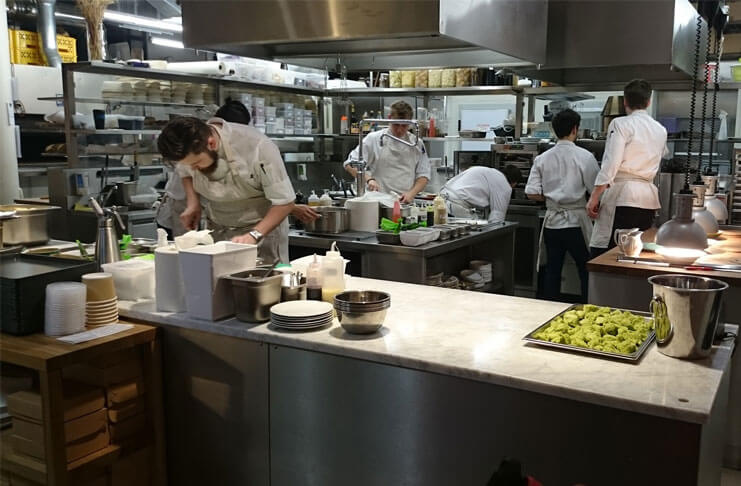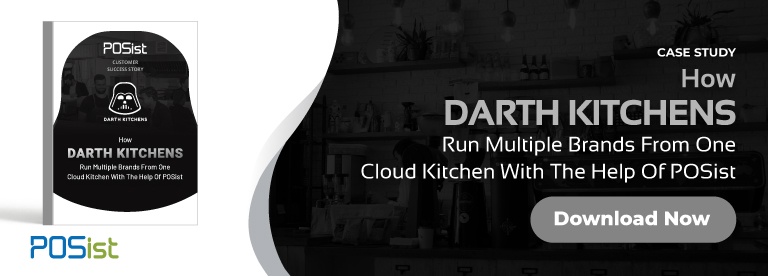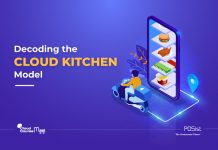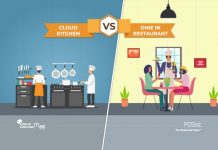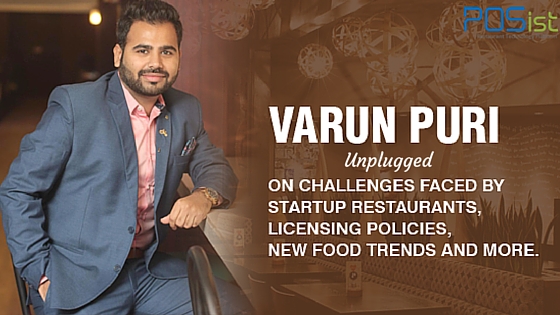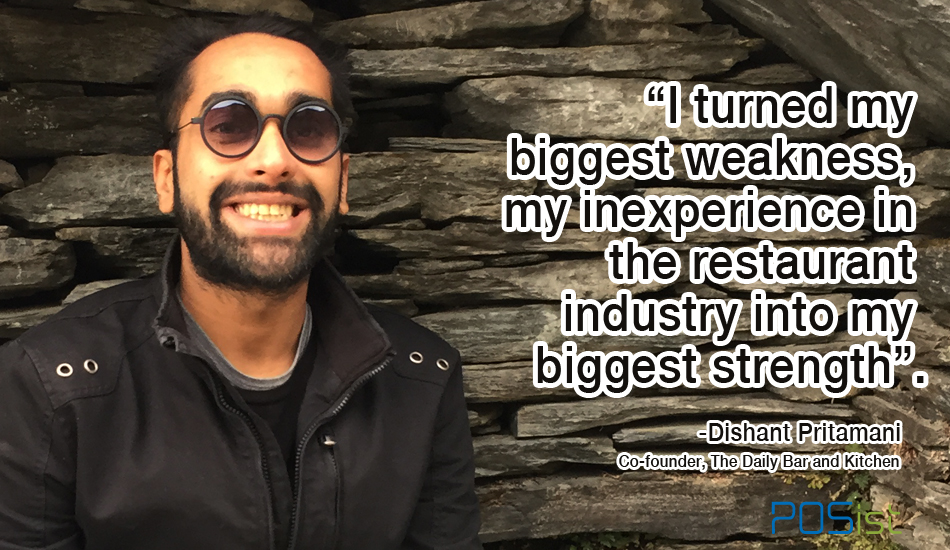Before the advent of multi-brand cloud kitchens, the evolution of delivery-only restaurants began with a single-brand cloud kitchen model. Cloud Kitchens, also known as ghost kitchens, virtual kitchens, and dark kitchens have proved to be major disruptors in the restaurant industry. A sharp rise in customer demands for food delivery, low investments, and the availability of third-party aggregator platforms were the main factors that popularized delivery-only restaurants.
Specializing in a single cuisine, standalone cloud kitchens had a limited customer base and lesser margins. To combat menu fatigue, capture a larger market, and increase customer frequency, famous brands like Faasos and Box8 embraced the concept of multi-brand cloud kitchens.
A multi-brand cloud kitchen model owns several brands, under one parent company. All the brands share large kitchen space, under one roof. Each brand is cuisine-specific and positioned in a way that caters to different customer needs. Though there are different multi-brand cloud kitchen models such as coworking kitchen space and cloud kitchen operators, this article focuses more on Multi-brand cuisine-specific cloud kitchen model.
How Are Multi-Brand Cloud Kitchens Blooming And Revolutionizing The Delivery Business
According to an intricated report on the Restaurant Industry & Market Evolution, 52% of foodservice operators placed their bets on setting up a Cloud Kitchen or a delivery-only outlet of their brand.
With minimum entry barriers and low capital costs, Multi Brand cloud kitchens are more profitable to set up than the traditional restaurant and even standalone cloud kitchens. Multi Brand Cloud Kitchens cater to a wider audience and have the capacity to leverage growth levels from a single kitchen unit. Efficient utilization of resources, adequate inventory levels, and controlled food costs provide better predictability in the business.
Let’s understand how multi-brand cloud kitchens are revolutionizing the delivery business
Better Understanding Of Customer Perception
Multi Brand Cloud Businesses are more versatile. Being delivery-only restaurants, cloud kitchens have an exclusive presence on websites, mobile apps, and online food aggregators platforms. With a niche focus on improving delivery, cloud kitchens implement better technology to manage food deliveries very scientifically. Restaurateurs have a deeper understanding of their customers. Cloud kitchen restaurant marketing is more focused, direct, and data-driven. Restaurants target the customers on the basis of their consumption behaviors and cuisine preferences.
As multi-brand cloud kitchens are not limited to a single cuisine they ensure a wider audience reach. Say a cloud kitchen brand famously known for Indian cuisine changes its menu to Italian, it might not do well with customers. However, launching the Italian cuisine items under a different brand name would work wonders. With multi-brand cloud kitchens, it is easier to bring a different set of customers to one’s platforms.
Customers usually don’t repeat the same order frequently and it becomes difficult for a single brand to convert first-time customers into regular customers. However, multiple brands can cater to the different requirements of the customers. If a cloud kitchen has three brands under its name, each serving breakfast, lunch, and dessert items respectively, it is capable of enticing the same customer to order three different meals. Cloud kitchen brands can offer endless possibilities and deliver better value to customers.
Utilization Of The Same Infrastructure And Resources
One of the best advantages of multi-brand cloud kitchens is that all the brands operate in the same space. Multi-brand cloud kitchens utilize the same kitchen space. Each brand that is specific to a different cuisine utilizes the same kitchen equipment, restaurant staff, and raw materials. The cost to run the kitchen of one physical restaurant brand and that of a multi-brand cloud kitchen is the same. Multi Brand cloud kitchens have better economics as more demand can be easily generated from the same resources. Utilization of the same resources significantly reduces the overall costs of running the cloud kitchen.
“In brick and mortar restaurants, the front-end of the restaurant has to be appealing. With Cloud Kitchens, you are relieved from the baggage of creating a frontend,” says Abhimanyu Maheshwari, Founder- Zing Restaurants
One-Time Investment
Most of the dynamics of traditional restaurants are unsustainable. There are high capital investments required for overheads such as fixed costs, high rentals, maintenance costs, etc. As the cloud kitchen business is devoid of front-end operations, there is no risk of capital involved. The Cloud kitchen model only requires a one-time investment for streamlining the backend operations. Their owners have a better ability to invest in proper equipment, good infrastructure, trained staff, and better technology to ensure standardization. This also provides better stability to cloud kitchen restaurants and enables them to focus on the niche they serve by delivering quality in food and packaging.
Reduced Logistics Cost
In the restaurants, customers rate the overall experience on different parameters like the ambiance, overall service, food, food presentation, etc. The only touchpoint in the cloud kitchen is the delivery of quality in both food and packaging
Multi-Brand Cloud Kitchens act as a central hub for delivering orders. Since these are delivery-only restaurants, the focus is more on ensuring speedy delivery. Delivery orders are either fulfilled through a deeply integrated food delivery system, third-party delivery services, or via online food aggregators.
Online Food Aggregators have been a major boon for food delivery businesses. But with high margins in each order and deep discounting, restaurants are left with thinner margins. The margins are also not very profitable for standalone cloud kitchens. Multi Brand cloud kitchens have the better bargaining power to negotiate more favorable deals with the Online Food Aggregators.
They have a wider presence with multiple brands on online platforms. One delivery personnel can take several orders from multiple cloud kitchen brands from one place and deliver the order faster. The cost of delivery comes down for the online aggregators also.
Low Cost Of Experimentation
Multi-brand cloud kitchen businesses are flourishing because of their flexibility to change and innovate. If an already existing cloud kitchen brand wants to expand the business in a different vertical, they can easily experiment. Based on customer feedback and market research, if they find people eating more healthy food, then they can create a healthy food brand.
The cost of launching a new brand online is very low compared to launching a brand offline. All it takes is to choose a brand name, update the brand name on the online listing and purchase the inventory items required for preparing the items. Even if the new brand fails to do well, only the brand name needs to be scrapped from the online platforms. There is hardly any experimentation cost and the cost of failure is negligible as compared to physical restaurants.
Multi Brand Cloud Kitchens have been the classic trendsetter of innovation and versatility. With a large customer base, wider menu options, and better margins, multi-brand cloud kitchens are set to bring about a revolution in the delivery business. To know how to facilitate your multi-brand cloud kitchen operations with ease, contact us!


